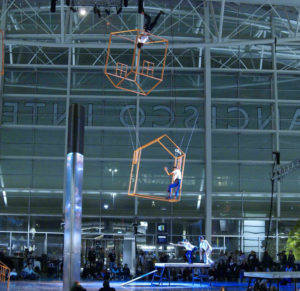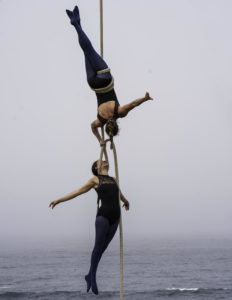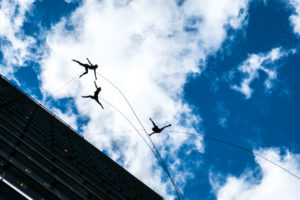An extraordinary public event approaches. Thrill seekers, arts enthusiasts, hard to please skeptics, this spectacle will not disappoint. Come August – if the crisp, bay breeze at Fort Mason Center doesn’t blow you away, the aerial dynamics of the 2018 San Francisco Aerial Arts Festival certainly will.
One of the many beauties of this art form is its all-inclusiveness – enabling people of all skill levels to partake at nearly any age. While dance training in aerial arts is not a requirement prior to learning the art form, it’s an obvious preference among performance professionals.
The aerial arts movement is rich in local history. Fascinated by the deeply rooted origins local pioneers implanted within this ever-evolving art form, choreographer Joanna Haigood became inspired. Taking this passion to heart, Haigood founded the San Francisco based aerial dance company Zaccho Dance Theatre in 1980. With the formation of Zaccho, Haigood maintained three primary objectives – to help strengthen the aerial arts community, build an audience, and one-day present a world-class aerial arts festival in the very city that helped catapult the art form into its current burgeoning state.

Offering a wealth of knowledge on aerial dance’s relevant local history, Haigood shares, “Terry Sendgraff, the founder of Motivity and inventor of what is now called the dance trapeze, blazed the trail here in the early ‘70s. This was also the beginning of the beloved Pickle Family Circus, leaders in the American New Circus Movement. Wendy Parkman and Judy Finelli, a brilliant aerialist and juggler with Pickles, then founded the San Francisco School for Circus Arts in 1984 (now Circus Center).”
She continues, “While the roots of aerial dance are most certainly in the circus arts, I think it draws equally on the contemporary dance forms that were explored by great contemporary dance masters like Trisha Brown. In the late ‘60’s she created a work called Planes, which involved dancers climbing on a vertical wall. We can say that this was the foundation piece for what is now known as danse escalade.”
Discussing her own personal influences, Haigood adds, “[Many] early forms of aerial dance that are still known are the ceremony/ritual dance of Los Voladores in Vera Cruz, Mexico. Another personal inspiration for me is the Japanese fireman’s ladder drills.”
As a major award winning, visionary choreographer, Haigood also has her own unique approach to creating aerial dance works. She says, “Most of my work centers around place – how it is defined, and the role that memory plays (I often think of place as a material memory bank). I consider specific qualities and structure of a place. I trace past events and engage with community. I watch nature and respond. This is generally how I start and the character of the work eventually emerges.”
Flourishing since the company moved to its 4,000 square foot, Bayview-Hunters Point, warehouse studio space in 1989, Haigood stuck to her commitment to strengthening the aerial arts community and building its audience through a variety of exhaustive efforts including in-studio performances, classes, workshops, residencies, youth summer camps, free after school arts programs for at risk youth, and finally – the company’s first Aerial Dance Festival which debuted in 2014.
Of course, prominent festivals as the Frequent Flyers International Aerial Dance Festival in Boulder, Colorado (the first event of its kind) held annually for the last 30 years – serve as inspiration for many aerial dance companies worldwide.

In 2009, Festival les Rencontres de danse Aérienne (the International Aerial Dance Encounters) in La Baule, France and the Irish Aerial Dance Festival in Letterkenny launched festivals of their own; while the European Aerial Arts Festival in Brighton, England followed suit in 2010.
In 2014, Zaccho wasn’t the only U.S. based aerial dance company eager to start a new regional festival closer to home. Aerialists in Santa Barbara had the same idea by launching the Floor to Air Festival that same year. In 2016, artists in Atlanta started their first festival, with Seattle right behind them, launching the Apogee Aerial Dance Festival in 2017.
Haigood has high hopes for the Aerial Arts Festival. In addition to her continuous efforts toward building an audience and the festival itself, Haigood hopes to position San Francisco as the foremost aerial performance community in the U.S. While these goals may seem ambitious, the concept is hardly inconceivable. “We’re absolutely committed to building the aerial arts field by providing opportunities for emerging as well as more established artists to take part,” says Haigood.
To reach the level of stature Haigood had envisioned, the festival needed to expand. Two years following the inaugural festival at Haigood’s studio, she took the festival to a larger and more centralized public space in 2016 – Fort Mason Center – where the festival will resume this August.
Enthusiastic about the festival’s progression thus far, Haigood shares, “We love being at Fort Mason and are so grateful for their support as co-presenters. We’re also looking to grow the festival and expand to other venues and sites around the bay. All in good time!”
Looking ahead, Haigood says, “We’re planning a piece for next year on Mount Tamalpais based on the history of the nuclear radar station that was built there, its history and personal stories of those connected to the site. 2020 marks Zaccho Dance Theatre’s 40th anniversary. We are in the process of designing a citywide celebration.”
This year, spectators can expect to see a fun mix of dancers, gymnasts, circus artists, as well as arts enthusiasts. By the end of the day, attendees are sure to leave feeling comfortably versed in the language of aerial arts, while other visitors from the industry will get to take home practical tips on the latest aerial dance technology and techniques.

Sure to be a festival highlight is the celebrated BANDALOOP aerial dance company, founded by vertical dance pioneer Amelia Rudolph. This year, BANDALOOP plans to unveil a newly choreographed women’s quintet and will also present an encore performance of their signature work HARBORING.
BANDALOOP has been featured in Harpers Bazaar and has performed before millions throughout Europe, Africa, the Middle East, the Americas, and Asia. BANDALOOP is also a current content partner for GoPro cameras – now showcasing dance footage of the company’s “Dance on Budapest with BANDALOOP,” captured on HERO5, HERO6, and GoProFusions.
Still a relatively young festival, after just three bi-annual events, the momentum at which the festival has grown is rather remarkable. With Zaccho Dance Theatre’s upward movement toward breaking new ground in aerial dance and expanding their local and international presence through touring and creating works all over the U.S., Europe, and South Africa – it’s hardly premature to declare that both the city of San Francisco and the Aerial Arts Festival serve as primary performance destinations on the global arts map.
This article appeared in the July/August 2018 edition of In Dance.


